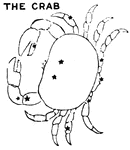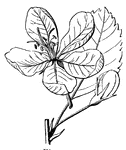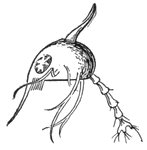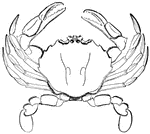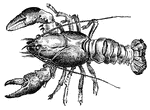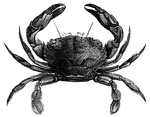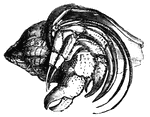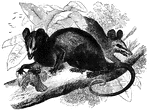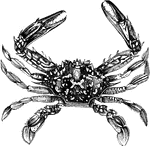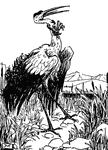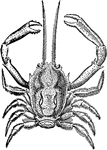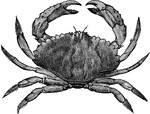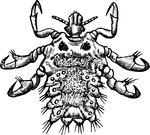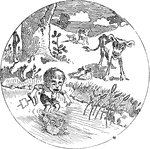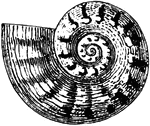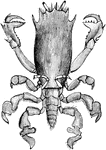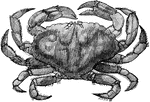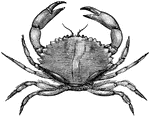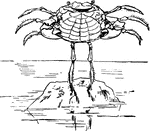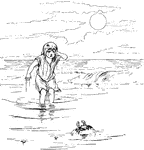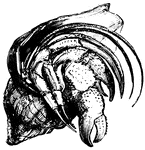
Hermit Crab
When alarmed, the hermit crab withdraws itself wholly into its portable house, closing the mouth of…
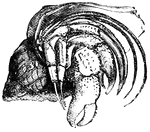
Hermit Crab
"When alarmed, the hermit crab withdraws itself wholly into its portable house, closing the mouth of…
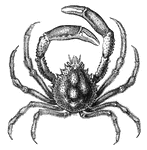
Spider-Crab
Crabs are ten-footed crustaceans. The abdomen is tucked out of site, so that nothing is visible except…

Horseshoe Crab
Horseshoe crabs represent an order called Xiphosura, from the fact that the end of the abdomen is furnished…
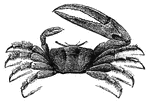
Fiddler Crab
A crab having one claw much larger than the other. As they walk sideways, they hold up the large claw…

Crab-Eating Raccoon
"The raccoon is about twenty-six inches long; the tail eight inches; the weight twenty to twenty-five…

Blue Crab
"Several species of crabs are taken from Florida coastal waters, probably the most common being the…
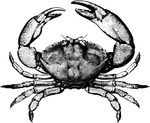
Stone Crab
"Stone crabs are popular with Floridians and Florida visitors, and are featured on restaurant and hotel…
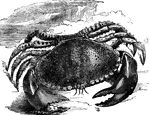
Common European crab
"These have the shell regularly rounded in front and narrowed behind; the legs are of moderate length,…
!["[The paguridae] includes the Hermit or Soldier Crab, <em>Pagurus Bernardus</em>, the abdominal portion of whose body is quite soft, forming a sort of cylindrical fleshy mass behind the shelly cephalothorax. As the comfort of the animal would be materially interfered with were this soft, worm-like appendage exposed to be grabbed at by every passing fish who might take a fancy to it, he usually seeks some shelter for its tail, and the habitation selected is generally the empty shell of some univalve mollusk." — Goodrich, 1859](https://etc.usf.edu/clipart/14900/14983/hermit-crab_14983_mth.gif)
Hermit-crab
"[The paguridae] includes the Hermit or Soldier Crab, Pagurus Bernardus, the abdominal portion…

Purse-crab
"The Purse Crab, Birgus Latro is a very curious species found in Amboyna and some of the adjacent…
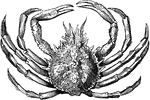
Spinous spider-crab
"In these the back is usually covered with spines and hairs. They generally live in deep water, and…
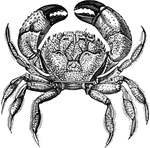
Eriphia spinifrons
"The Eriphea spinifrons, for instance, distributed in nearly all seas, has the front covered…
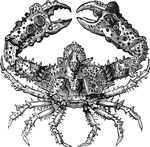
Parthenope horrida
"The Parthenope horrida, a native of the Atlantic and Indian Oceans, is covered with the most…

King crab
"It is among the largest of crustaceous animals, sometimes measuring as much as two feet in length.…

Water Opossom
"Opossom is the popular name for the pouched mammals which have a geographical range from the United…

Procyon Lotor Raccoon
"The Raccoon, or Racoon, is a handsome animal, about the size of a large cat, brown furry hair, tail…

Cobia
A spanish name for a sergeant&mdashfish. Usually has a uniform shape with a wide flattened head, and…

King Crab
A genus of crabs so called from their great size. They are found in the tropical and northern coasts…
Crab Design
A border design having the appearance of a series of crabs with their claws extended. Very common in…
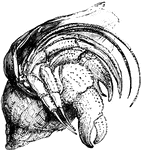
Hermit Crab
Decapod crustaceans of the superfamily Paguroidea. Most hermit crabs salvage empty seashells to shelter…

Crab
This illustration shows a crab, a species of cancer. Crabs are decapod crustaceans with thick exoskeletons.
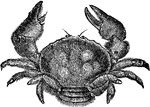
Sponge Crab
A crab that usually hides in sponges on the ocean floor. It apears soft because of the algae that grows…

Prawn
A small crustacean about 3 to 4 inches in length and marketed in vast numbers. Ate throughout the world.

Crab
"Transformations of the Crab: 1, young crab, or zoea, magnified; 2, young crab, in a more advanced stage,…
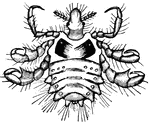
Crab-louse
The crab louse can live in almost any form of human hair, leading to its other common name of pubic…
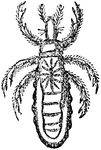
Crab Louse
Pediculus Pubis. The crab-louse is gray-black and is a much broader square form than the other two species…
